Every exercise in a workout routine has a specific role. Some help in burning calories, improving fitness, building muscles, conditioning specific body parts, and some pack all these purposes in a single series of movement. Although, there is a workout and training goal in which almost every exercise can fit in, some movements are simply more effective in building muscle and strength than others.
To be frank, there is no way to tell which exercise is more effective or whether one is better than the other intended for the same purpose. However, there are some situations and conditions which warrant a change in a workout routine. If you have hit a plateau or can’t see the results that your efforts warrant, then it is a time for a change and these seven great strength training exercises will yield better results including improved strength, better core stability, greater athleticism, and improved overall health.
-
Goblet Squat
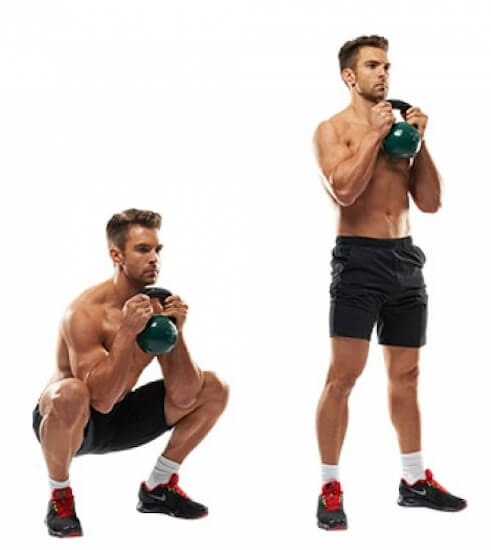
The squats are arguably one of the best exercises out there. Its ability to hit, activate and engage more than 100 muscles make it an ultimate compound exercise. Unfortunately, people often struggle to get the form right with barbell loaded on their shoulders, especially beginners. This makes goblet squat an ideal choice for those progressing from the bodyweight squat, as the form and movement in this exercise is easier to learn. And, in case you are an expert, who has been popping those squats for years now, the goblet squats provides you with an ideal opportunity to break out of plateau and to add a dynamic to your routine. Isn’t it easy? No mate, try to do it with a kettlebell weighing 100 pounds and drop low.
Hold a dumbbell with both the hands like a bell at your chest level. Set your feet shoulder width apart with toes pointing slightly outwards. Now, contract your core and start descending low. Descend until your elbows reach the inside of your knees. Keep your feet flat on the floor and pause for a moment. Press your feet onto the floor and drive out of the low position and return to the standing position. If your heels come off during the movement, then your stance is too narrow. And, also remember that your chest should be up throughout the exercise, drooping forward is very bad form that could cause long term back problems.
-
Pallof Press

Pallof press is one of the most complex exercises around. And, it is due to the complex form, the pallof press is extremely underused. However, if you are one of those who have not even heard of this incredible exercise routine or despite knowing about it, have rarely done, then it is about time, you start sculpting your core with it. While, you aren’t going to lift heavy weights, the effort needed to resist the rotation is very challenging. The anti-rotation movement in the exercise will engage your entire core including obliques, abs, lower back and even your glutes. Not only, the pallof press will add definition to your midsection, it will also enhance your core strength.
With feet set at shoulder width, assume a stance perpendicular to the cable column with column’s arm set around shoulder height. Now, grab the handle with both hands and pull it towards the chest, maintain the tension on the cable. Remember the feet, knees, hips and shoulders all should remain square, facing ahead throughout the movement. Hold the chest high, squeeze your core and press the handle away from the body by extending the arms straight while resisting any twisting pull or rotation. At this point, the resistance would be highest and strongest. Continue holding the contraction in the core, ensure you remain square, straight and resist the rotational force. Now, slowly bring arms back towards the body.
-
Dumbbell Row

Often, the majority of people show more tendency to develop muscles that they can see, which they believe other will notice on the first glance. However, developing the back is equally important. Not only developing back creates a balance in your body and improves your posture, but also is a key in developing an awe-inspiring physique. A well-developed physique gives you the much vaunted and desired v shape. Dumbbell row is one such exercise that can help you in developing a broad and strong back. Along with targeting the main muscle group including lats, traps and rhomboids, the dumbbell row also builds strong arms and core. And, here is how you should it.
Choose a flat bench and place a dumbbell on each side of it. Now, place the right leg on top of the end of the bench and lean your torso forward from the waist, ensure your upper body is parallel to the floor. For support, place your right end at the other end of the bench. Pick the dumbbell with your left hand, while keeping your lower back straight.
Now, pull the weight straight up in to the left side of your chest. Your torso should remain stationary during the movement and upper arm close to the body. Remember only the back muscles should be used in pulling the weight up, the forearm should only work on holding the dumbbell. On reaching the contracted position, squeeze your back muscles. Breathe out as you perform this movement.
Lower the weight straight down, slowly and steadily. Breathe in as you perform this step. Repeat the movement for as many repetitions as you could do with proper form and then switch sides.
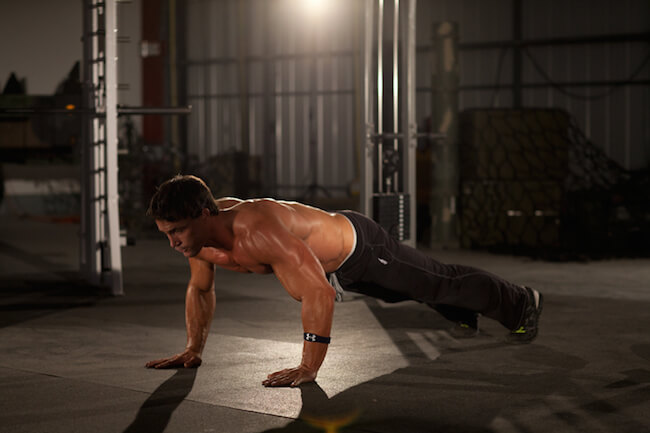
Push ups is one of the most basic and simplest strength building exercises out there. Don’t be fooled by the simplicity of form and movement because push up is also one of the most effective strength building exercises out there. The exercise movement is great for targeting upper body pushing muscles – the anterior deltoids, triceps and chest. It also engages your core and allows better range of movement of the shoulder blades. Another benefit of the pushups is that it is an effective fat burning exercise. And, you can do them anywhere, anytime. No equipment needed. Just drop on the floor and start doing them. Even if you have a window of 15 minutes in your daily routine, you can do pushups.
Plant your hands flat on the floor at the shoulder width and directly under the shoulders. Assume the plank position by straightening the legs out behind, the weight should be distributed on hands and feet. Contract your core and brace your glutes, to ensure that your body is rod straight. Now, slowly lower your body to the floor. The elbows shouldn’t flare out and form a T letter. They should be tucked closer to the body forming an arrow. Lower your body until your chest is just above the ground, hold on for a count of two and then explode back to starting position by fully extending your arms.
If you can’t do more than five without a proper form, place your hands on an elevated position (edge of bed, chair or block) and build your upper body strength. And, in case you feel the normal push-ups are too easy for you, you can elevate your feet and wear a weighted vest. You can opt for martial arts style knuckle push ups as well.
-
Split Squat
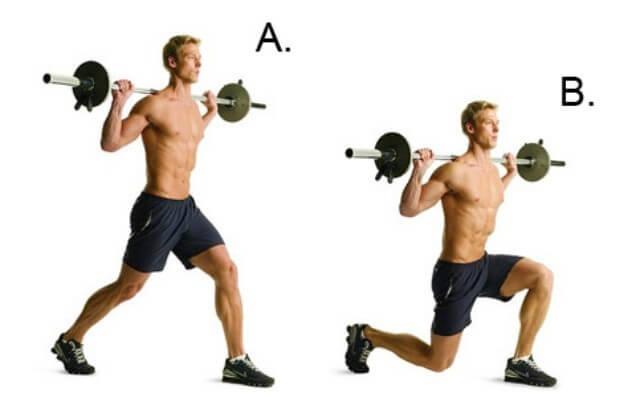
The traditional squats are great. Yes, they can help you hit several muscles in single movement and bring many others in for stabilizing. But, it’s important that you incorporate the single leg squats to improve your athleticism and to ensure symmetric development of the lower body. The split squat is also great for the beginners who find it difficult to master the traditional squat form. The wider base in this exercise means that you won’t have as many problems as you have in usual squats in maintaining your balance. The split squats along with primarily targeting your quads, glutes and hamstrings also engages the stabilizing muscles of the hips and trunks. Along with building lower body strength, the split squat improves flexibility, balance and hits your core harder than the traditional squats.
Stand with your feet shoulder width apart. Take a step forward with your right foot and a step backward with your left foot. Now, with the front heels pressed flat on the ground, descend into a lunge and bring the back knee towards the floor. Descend until your back knee is near the ground. Remember the front heel should remain flat on the floor. Pause for a count of two in the position and start rising up to the starting position. Perform 8-10 repetitions and then switch your leg.
-
Lateral Squat
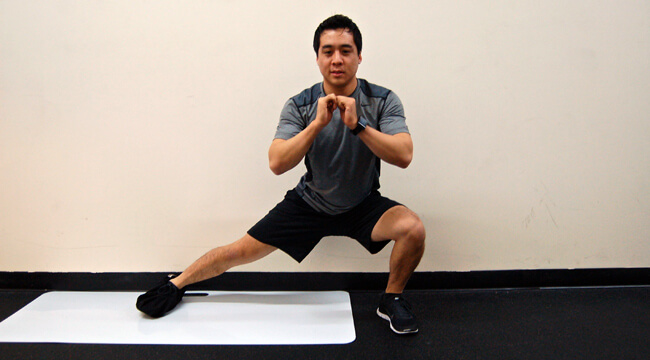
The lateral squat combines the benefits of two movements – lateral lunge and squat in one movement. Unlike, the traditional lunge, this is a stationary exercise which involves side to side movement, which provides a great stretch on the groin and inner thighs and at the same time, it engages muscles in thighs, hips and core.
To do this wonderful exercise, stand with your feet wider than your shoulder width and planted firmly and flat against the floor. The toes should be pointing straight ahead. Now, start the movement by pushing your hips backwards. Bend your left leg, lean to your left and slightly angle out your right foot. The weight of your body should be on the left side, the left knee should be bent and left foot should be flat on the floor. Hold on for a second and start moving back to the upright position. This is one repetition. Now, do the same movement towards the right side to balance out the effect of the exercise.
-
Hip Extensions
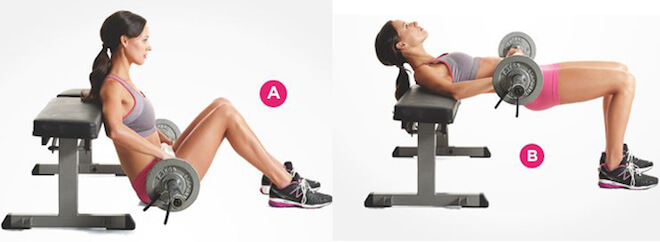
The glutes are one of the most important muscle groups in the body. The athletes and outdoor enthusiasts need great glutes for balance and better lower body strength and agility. In general, the glutes are elemental in improving your posture and avoiding lower back pain. Despite being so important for the body, the glutes are criminally under trained and overlooked in favor of those muscles that are more visible such as quads, hamstrings and calves. Remember that movements ranging from squatting to running needs strong glutes, otherwise you run the risk of injuring your hips, knees and ankles. And, hip extension is an ideal exercise to develop strong and functional glutes. Here, are the steps that will tell you how to do hip extensions.
With feet planted firmly on the ground, place the back of your shoulders firmly on a flat bench. Your knees should be bent to balance your weight. Now, squeeze your glutes, push through your heels to rise up into the bridge position. The hips should be fully extended in this position. The body from shoulders to the knees should be in a straight line and the knees should be bent at 90 degrees. Pause in the position for a moment by engaging the core, glutes and hamstrings. Now, lower the hips and drop into the starting position. Do 8-10 repetitions over three sets. For the beginners, the body weight is enough. However, those who find it easier to do, can add a weighted barbell to make it more challenging.
